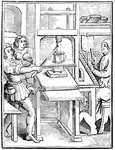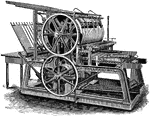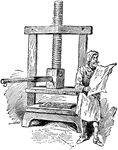Clipart tagged: ‘printing’
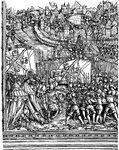
Troops Entering a Town After a Siege
Troops Entering a Town After a Siege is a woodcut that was created by German artist Albrecht Dürer.…
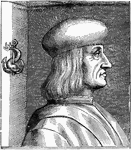
Aldus Manutius
(1449-1515) An engraving print of Aldus Manutius, one of the first printers and founder of the Aldine…
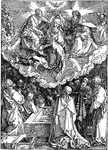
The Assumption and the Coronation of the Virgin
The Assumption and the Coronation of the Virgin is a woodcut created by Albrecht Dürer in 1510.…

The Investiture of the Duke of Milan
The Investiture of the Duke of Milan is a woodcut that was created by German artist Albrecht Dürer.…
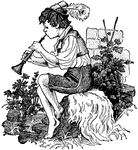
Benday Engraving
"The Benday process, so called, is the use of mechanical appliances for adding lines or stipples to…
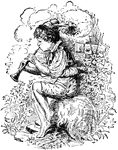
Line Engraving
"The making of line engravings follows the same general course, with the exception that no halftone…

Wood Engraving
"The wood used for engraving is boxwood, nearly all of which is imported from Turkey." —The Popular…

John W. Foster
(1648-1681) Established the first printing office in Boston and is known for the earliest woodblock…
Printers' Galley
"In printing, an oblong shallow tray of brass or wood, rarely of zinc, on which the compositor deposits…

Christ Taken Prisoner
Christ Taken Prisoner is a woodcut by German artist Albrecht Dürer in 1510. It is part of a series…
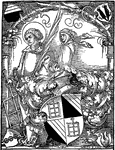
Bookplate of Hector Pomer
This bookplate of Hector Pomer is woodcut that was created by German artist Albrecht Dürer. Pomer…
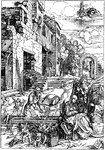
Repose of the Holy Family in Egypt
The Repose of the Holy Family in Egypt is a woodcut that is part of a series "Life of the Virgin" by…
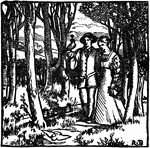
Art in the House
This print is part of a series of woodcuts called Art in the house that was designed by English artist…
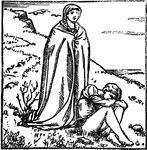
Art in the House
This print is part of a series of woodcuts called Art in the House by English artist Robert Bateman…
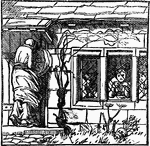
Art in the House
This is part of a series of woodcuts called Art in the House that was designed by English artist Robert…
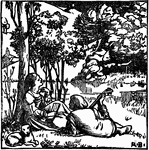
Art in the House
This is part of a series of woodcuts called Art in the House that was designed by English artist Robert…
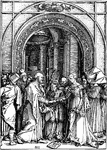
The Marriage of Joseph and Mary
The Marriage of Joseph and Mary is a woodcut that is part of a series "Life of the Virgin" by Albrecht…
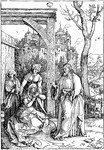
Christ Taking Leave of His Mother
Christ Taking Leave of his Mother is a woodcut that is part of a series "Life of the Virgin" by Albrecht…

Letterpress Printing Lowercase Tray
Tray containing the lowercase letters of the alphabet, used in the letterpress printing process. Known…

Letterpress Printing Uppercase Tray
Tray full of capital and small capital letters and symbols used in the letterpress printing process.…
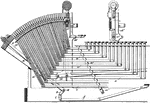
Linotype Machine
A Linotype machine is a line casting machine used in printing. The machine revolutionized printing and…

Early Model Linotype Machine
The Linotype machine is a line casting machine that is commonly used in printing. This machine modernized…
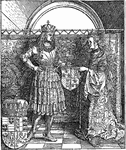
The Emperor Maximilian and his Bride, Mary of Burgundy
The Emperor Maximilian and his Bride, Mary of Burgundy is a woodcut that was created by German artist…
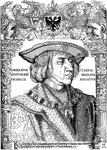
Emperor Maximilian
This a woodcut portrait of the Emperor Maximilian. It was created by Albrecht Dürer in 1519. A woodcut…

Albrecht Dürer's Pirkheinmer Border
Albrecht Dürer's Pirkheimer Border is a woodcut that was created by German artist Albrecht Dürer…
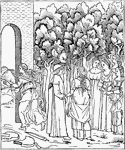
Poliphilo in the Garden
The engraved illustration of Poliphilo in the garden from Hypnerotomachia Poliphili, one of the first…

Columbian Press
George Clymer improved upon Gutenberg's press by making it out of iron therefore reducing the force…

Double Cylinder Press
"Double cylinder press, 1835-1900. These presses were built up to 1900 and this picture shows the latest…

Hand Press
The hand printing press was invented by Peter Smith and manufactured by Robert Hoe in 1822.

Treadwell's Platen Printing Press
"Treadwell's wooden-frame bed and platen power press, 1822." -Hill, 1921
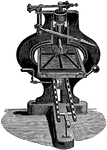
Stanhope Press
Charles Stanhope improved upon Gutenberg's press by making it out of cast iron therefore reducing the…

Printers Galley
In printing and publication, proofs are preliminary versions of publications. They may be uncut and…

Modern Printing Press
"The printing press- originating at the middle of the fifteenth, the art of printing continued to be…

Calico Printing
Calico printing was the first "operation connected with the printing of cloth."- Lupton

Copper-Plate Printing
"In all engraving upon metal plates the traces or marks which are to appear on the paper are cut or…

The Resurrection
The Resurrection is a woodcut by German artist Albrecht Dürer in 1510. It is part of a series called…

Sheep's Foot Tool
"In printing, an iron hammer with a split curved claw at the end which serves for a handle. The claw…

Slice Tool in the Printing Trade
"In printing, a small spade-shaped iron tool with which printing ink is taken out of a tub and conveyed…
Slice Galley
"In printing, a galley with a false bottom, in the form of a thin slice of wood, which aids the removal…

Stereotyping
"Stereotyping is the art of fabricating metal plates resembling pages of type, which impressions may…

The Virgin and Child Surrounded by Angels
The Virgin and Child Surrounded by Angels is a woodcut that was created by German artist Albrecht Dürer…
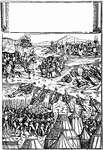
The Emperor Maximilian Receiving the Submission of a Besieged City
The Emperor Maximilian Receiving the Submission of a Besieged City is a woodcut that was created by…
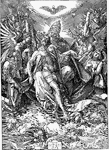
The Holy Trinity
The Holy Trinity is a woodcut that was created by German artist Albrecht Dürer in 1511. This woodcut…
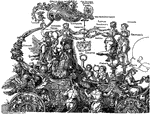
The Emperor Maximilian on the Triumphal Car
The Emperor Maximilian on the Triumphal Car is a woodcut that was created by German Artist Albrecht…
